What's Driving The NBA's 50-Point Boom?
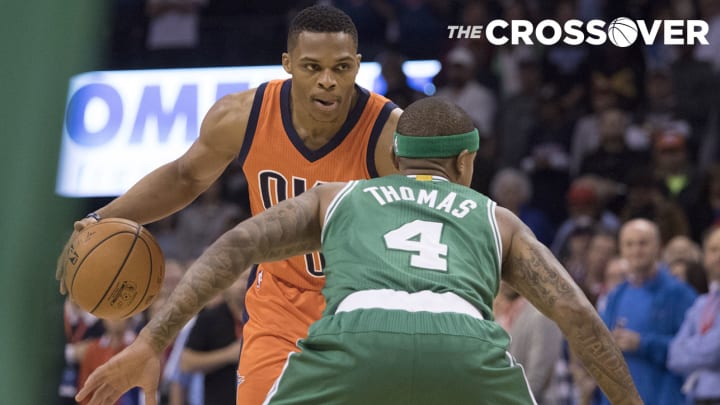
Scoring 50 points in a game is one of basketball’s most alluring accomplishments, a rarity that’s synonymous with all-time greats like Wilt Chamberlain, Michael Jordan and Kobe Bryant, a wonder that begins sweeping through an arena and trending on social media as the feat approaches.
When Boston’s Isaiah Thomas neared 50 last Friday, he could see his mother in the TD Garden crowd, encouraging him to pass the milestone with one open hand, five fingers splayed, and one closed fist. Not long after Houston’s James Harden became the first player in league history to post a 50-15-15 line Saturday, a compilation of the highlights dubbed “THE MVP RACE IS OVER” had surfaced on YouTube. As Chicago’s Jimmy Butler closed in on 50 on Monday, his teammates repeatedly fed him the ball for late free throws, with Michael Carter-Williams making sure that his All-Star teammate attempted a technical foul shot to reach the half-century mark.
These unforgettable and exhilarating moments are happening quite often this season. Indeed, the NBA is in the midst of a 50-point boom, one that has gradually picked up steam in recent years and that threatens to reach new heights. Entering Wednesday’s action, eight players had scored at least 50 points in 2016-17, equaling the NBA record even though the season is less than halfway over. Last season also produced eight 50-point scorers, tied with 1989-90 for the most ever.
For context, when Thomas, Harden and Butler each hit 50 points this week, they exceeded the total number of 50-point games in the 2010-11 season (2) in a span of just four nights. In other words, the trio packed what was recently a season’s worth of scoring fireworks into one long New Year’s celebration.
Number Of Different 50-Point Scorers
Create column charts
To set a new record, only one of the following players needs to go off for 50 at some point over the next 10 weeks: Stephen Curry, Kevin Durant, LeBron James, Kyrie Irving, Damian Lillard, DeMar DeRozan, Kemba Walker, Kyle Lowry, CJ McCollum, Karl-Anthony Towns, Andrew Wiggins or Kevin Love. All of those players, it should be noted, have scored 50 in past seasons or topped 40 already this year, making this a deep and very capable field.
There’s more history on the line too. During the three-point era, the NBA’s record for most 50-point games in a season is 18 in 2006-07, when a fully unleashed Bryant delivered 10 by himself. This season, the league is on pace for 18.7 50-point games and, even if the pace slows, there’s a strong chance 2016-17 will be the second-most prolific season of the three-point era.
Most 50-Point Games In A Season: 1980-2017
Create column charts
What’s driving this recent run of 50-point explosions? Many of the same principles that have produced what could be, as NBA.com’s John Schuhmann noted recently, the “best offensive season in 30 years.”
More Threes
The enhanced role of the three-pointer in modern offense has played a critical role in the recent 50-point boom. Here’s a side-by-side comparison that should drive home the massive generational shift at work:
• Michael Jordan had seven 50-point games in which he didn’t attempt a single three.
• Stephen Curry has made at least eight threes in all five of his 50-point games.
While NBA teams have been taking increasingly more three-pointers for more than a decade, Curry deserves significant credit for reshaping behavior and attitudes towards the shot. Yes, Bryant was the first to consistently take and make a high volume of threes en route to 50-point games, but he was the exception rather than the rule. Rarely do NBA players, even stars, operate with the level of independence that Bryant enjoyed during his high-usage peaks.
Giannis Antetokounmpo: The Most Intriguing Point Guard In NBA History
Thanks to Curry, who deployed Bryant’s quick-trigger approach with far greater accuracy and in an offensive system designed to maximize his shooting ability, it’s no longer out of the ordinary for a skilled three-point shooter to make eight threes, attempt 15 threes, pull up from well behind the line, take a quick three in transition, pass up a layup for a three, or toss up threes on consecutive possessions. “Heat checks” are becoming so common they barely warrant mention. “Bad shots”—at least for skilled three-point shooters—are harder and harder to come by. “Ball hogging” is a pejorative used by analysts with greater precision, handed out to chuckers with the worst True Shooting percentages rather than the guys who simply take the most shots.
Basketball strategy has also evolved from a general preference for the three instead of the long two to a purposeful desire to generate the best threes as often as possible. The best scoring lineups now feature four three-point shooters at a minimum, forcing defenses to pick between especially lethal poisons.
It took years for these factors to align—for players to make threes a dependable weapon, for coaches to take off the leashes, for management to construct three-friendly rosters, and for organizations to step away from old-school thinking—but the fruits of these labors have started to play out with greater regularity.
Thomas and Harden are both great cases in point. When Thomas scored 52 points, the most by a Celtic since Larry Bird in 1985, he hit nine threes. The very next night, Harden also hit nine threes. That’s two 50-point games with nine threes in roughly 28 hours. By comparison, there were only two 50-point games with at least nine threes during the first 28 years of the three-point line (from 1980 to 2008): Mahmoud Abdul-Rauf in 1995 and Bryant in 2003. What was previously considered a “once in a decade” shooting performance—an anomaly that would take place well outside the standard style of play—can now unfold on any given night.
It’s quite possible that no player will ever be able to match Jordan’s scoring instincts and ability, but quality three-point shooting in high volume has made Jordanesque scoring numbers more attainable for a wider pool of players.
Better Spacing
Coaches and analysts have long preached the secondary benefits of three-point shooting, namely the space that it creates for driving and cutting opportunities that lead to high-percentage shots at the rim and free-throw attempts. Rule changes that eliminated hand-checking on the perimeter and camping in the paint on defense only further encouraged teams to maximize room for their best playmakers.
Offenses that have fundamentally committed to the three-pointer are finding the approach pays major dividends for their stars. Entering this season, the 2015 Rockets, led by Harden, ranked first all-time with 32.7 three-point attempts per game. Right behind them? The 2016 Warriors, led by Curry and Klay Thompson, with 31.6. This year, Houston again leads the way by jacking up 39.6 threes per game, a mark that should set a new league record by a (very) comfortable margin.
The benefits of this ultra-spread approach to star players are easily recognizable, and the results are often both spectacular and frightening at once. Look no further than these shot charts.
On the left, Harden’s 53-point game against the Knicks on Saturday. On the right, Thompson’s 60-point outburst against the Pacers in December.
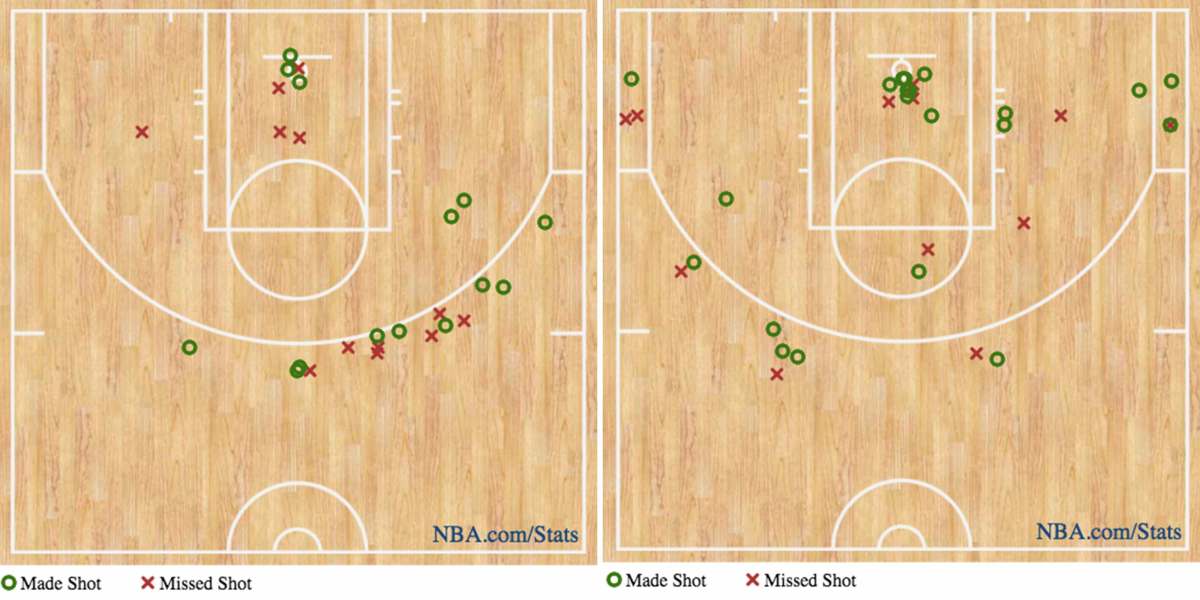
Both are masterpieces of efficiency: a vast majority of the shot attempts are threes or layups, and many in both categories were clean looks thanks to their deep range, their team’s spacing, their freedom to move towards the hoop, and the lack of set defenders to challenge their efforts. Such refined outputs, from an efficiency standpoint, were much more difficult to achieve when the rulebook was more restrictive and when the paint was more crowded with traditional frontlines.
Here’s a snapshot of one Harden possession in which he drove easily into the paint for a finish. Notice that Rockets sharpshooter Ryan Anderson is spotting up so far from the hoop that he’s not even in the screen, and yet his defender still can’t offer real help on Harden. With New York forced to match-up against Houston’s shooters, Harden gets to attack a defense wholly lacking in rim protection. (Needless to say, Derrick Rose didn’t come flying across the paint for a block.)
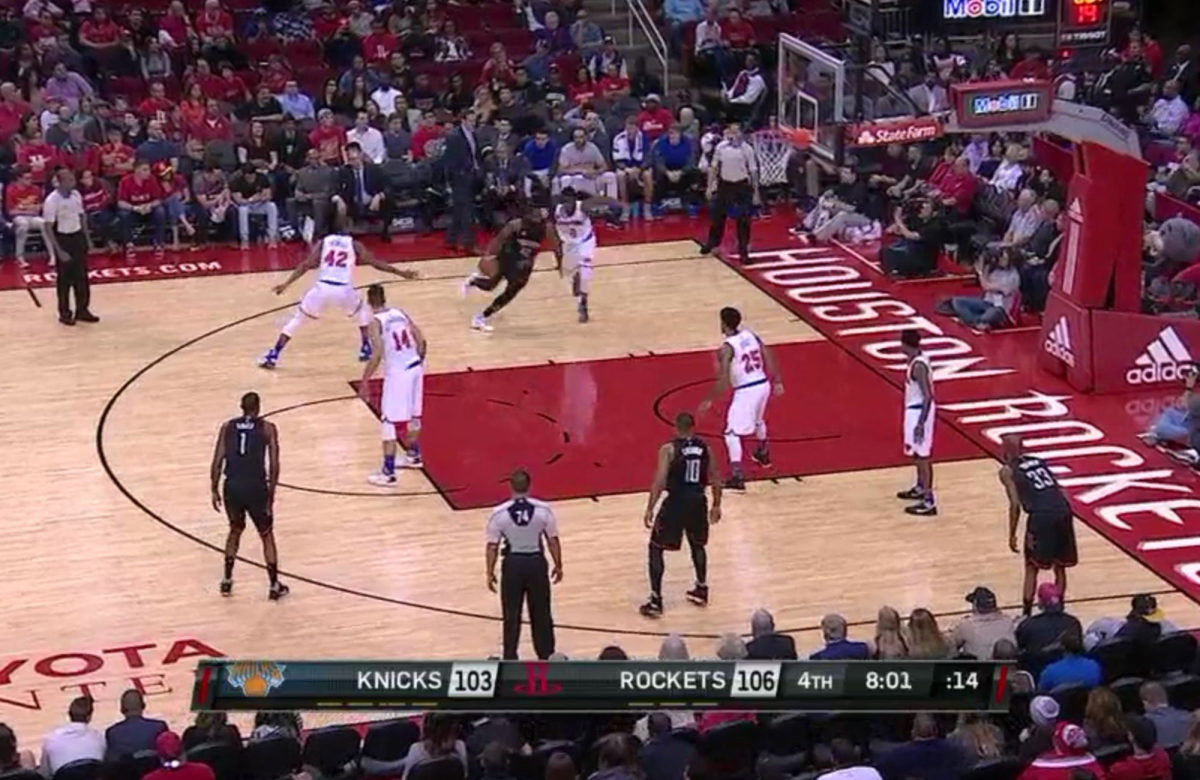
This next screenshot might as well be the cover of the Rockets’ next media guide under the headline, “Good luck.” Here’s Harden, barreling down on a defender (Joakim Noah) who has no chance of defending him one-on-one in space and with a head of steam out of a high screen and roll. The help defense can’t really come, thanks to the Rockets’ shooters keeping the court spread horizontally, and Harden scores without much effort by tipping in his own missed runner.
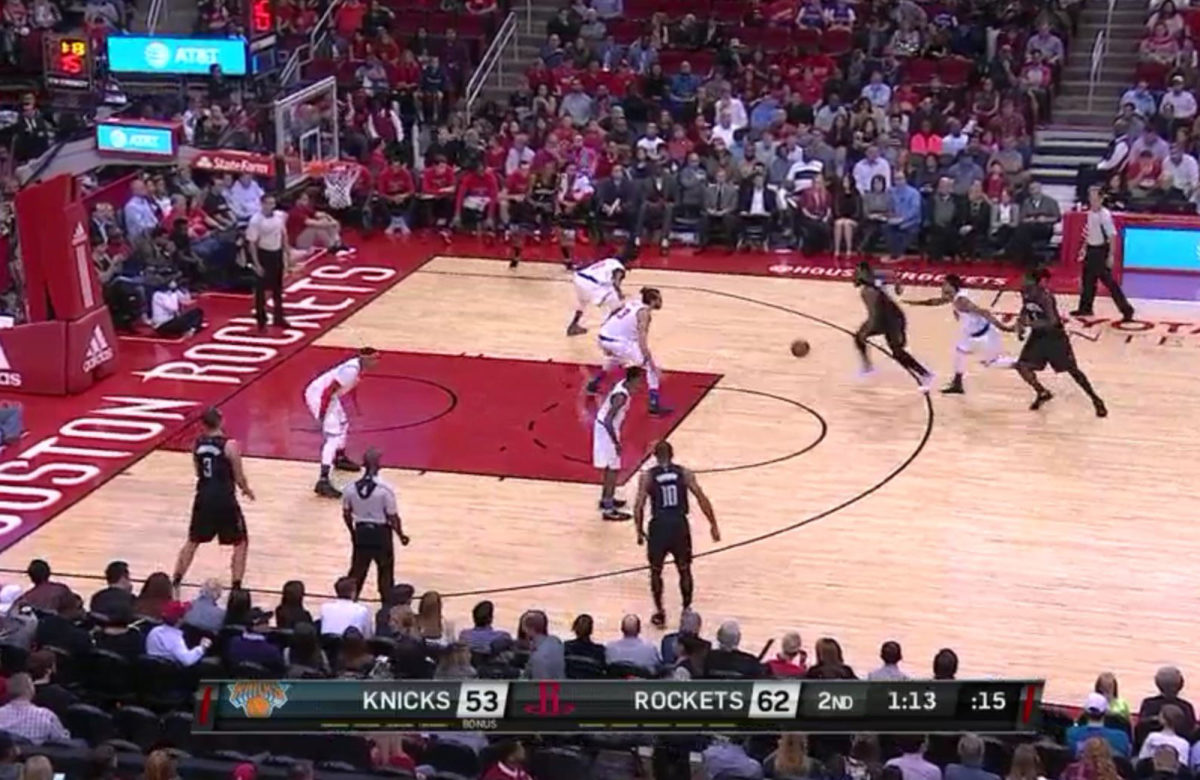
Two things make this especially scary: 1) Harden, like a chessmaster, has now accumulated thousands of repetitions in these scenarios and he has worked out all the pertinent opening moves and counters, and 2) Houston, as long as it stays healthy, can get him into similar mismatches on basically any possession when facing all but the most disciplined and connected of defenses.
Thompson’s scoring display against Indiana—60 points in less than three quarters—was similarly aided by easy twos. Somewhat remarkably, Thompson “only” had eight threes, doing most of his damage from inside the arc. On this shot, Zaza Pachulia leads him into a wave of space behind Indiana’s defense for a backdoor layup. Notice that Durant, like Anderson in the first picture, hasn’t even entered the screen and yet his defender is outside the play. Draymond Green and Curry are both on the weakside as shooting threats, pulling away any would-be helpers.
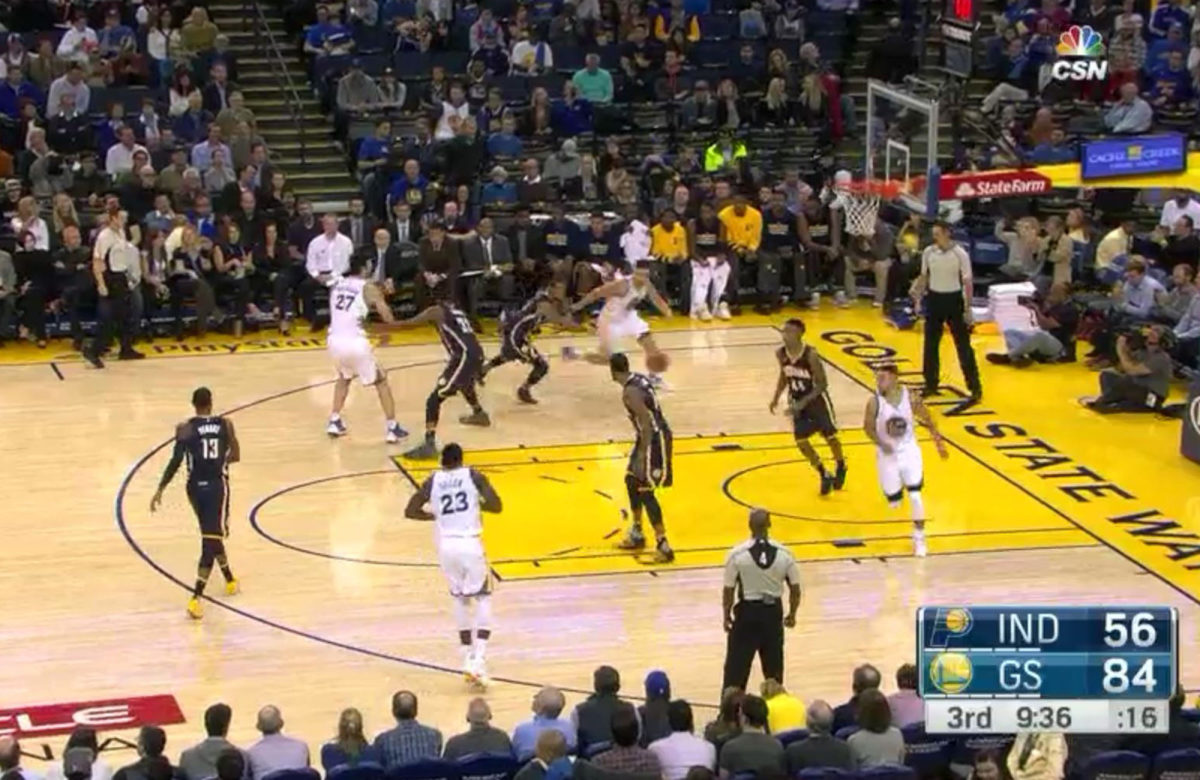
Similar deal on this one. Thompson bursts open behind the Pacers’ defense for another gimme layup as Curry, Durant and Green occupy their men well outside the basket area. Threes and cheap twos add up incredibly quickly compared to turnaround elbow jumpers or tough shots through double teams.
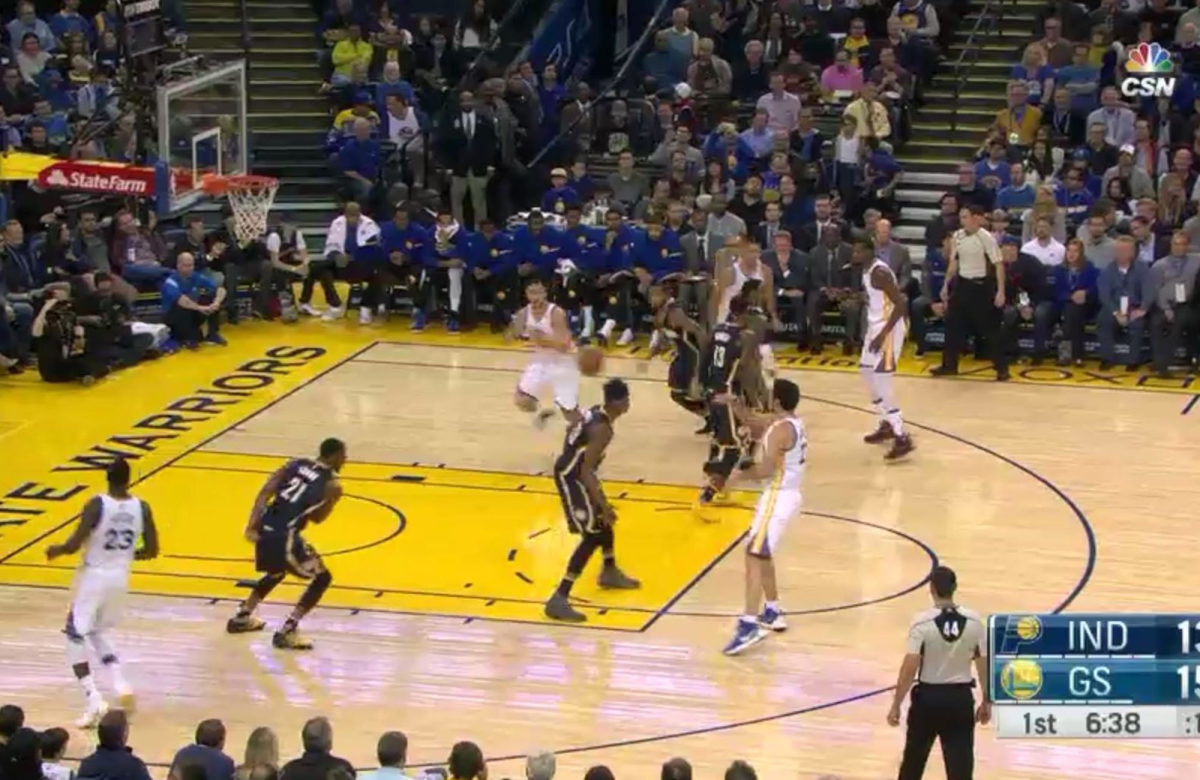
Boston has channeled this same approach, attempting more than 31 threes per game and doing its best to give Thomas room to operate in space, whether that means coming off high screens for clean threes right behind the arc or turning the corner on big defenders to get to the rim for layups.
When he was selected with the last pick in the 2011 Draft, Thomas’s 5’9” height was still viewed as a hard cap on his potential. As recently as 2015, the Suns weren’t ready to make him a starter and decided to part with him for little in return. This year, Thomas is a top-10 scorer leading a top-10 offense, and his height is far less important (on offense) than his combination of shooting, ball-handling and craftiness going to the hoop and the Celtics’ commitment to stretching out defenses around him.
Heavy Loads
Not all of this year’s 50-point efforts fit the easy, breezy model of scoring described above. Butler pounded out his 52 the old-fashioned way, hitting just one three and 21 free throws on a Bulls team that is desperate for better spacing. Early this season, Oklahoma City’s Russell Westbrook dumped in 52 points, even though he only made two of his 10 three-point attempts and is regularly surrounded by non-shooters. Washington’s John Wall and Sacramento’s DeMarcus Cousins have also both cracked 50 despite playing for teams that rank below-average in both three-point percentage and attempts. And let’s not forget Anthony Davis, who heroically poured in 52 points, outscoring all of his Pelicans teammates combined in a loss to the Nuggets.
Over the last two seasons, NBA teams have increasingly leaned on their stars more heavily when it comes to decision-making and shot-taking. The following chart shows the number of players with a usage rate of 29 or greater every year since 2000. Last year marked the highwater point with 16 such players. This year ranks second with 14.
Number of players with a usage rate above 29: 2000-2017
Create column charts
Six of this year’s 14 high-usage players have already turned in a 50-point effort: Westbrook, Davis, Cousins, Wall, Thomas and Harden. Many others—including James, Irving, Lillard and DeRozan—are firmly on the 50-point watch list.
To boil this down, some portion of these 50-point efforts are still coming by necessity and brute force, and more players are positioned to deliver them than in years past.
Westbrook stands as the most obvious case study given his 42.2 Usage Rate, which is the highest in league history, higher even than Bryant’s memorable one-man show in 2006. When Westbrook is on the court, Oklahoma City’s offense performs at a top-10 clip. When he’s off, the Thunder rank dead last. That level of dependence inevitably leads to gobs of shot attempts and, in turn, monster stat lines. It’s fairly safe to assume that Westbrook will crack 50 points again at some point this season, even though he’s also racking up the assists too as he compiles triple-double after triple-double. Oklahoma City’s attack requires eye-popping individual play from its best player just to get by.
There are a number of potential conditions influencing this load increase. Durant’s move to the Warriors obviously spiked Westbrook’s usage with the Thunder. The general talent consolidation in Golden State and Cleveland has increased the number of stars who are going at it alone for their respective teams. A rash of early-season injuries gave New Orleans no choice but to milk Davis for everything he was worth. Changing roster dynamics have opened the door wider for the likes of Harden and Kawhi Leonard. And the entire league has more data than ever—from health and performance monitoring to advanced analytics and lineup data—to help determine exactly how much stars can handle before their returns start to diminish.
Deep Talent
There’s one last point that should be raised, even if it runs directly counter to Charles Barkley’s recent grumblings about the state of the NBA.
The NBA’s talent pool right now is especially deep: All eight 50-point scorers this season are 27 or younger, all eight are All-Stars, six were lottery picks, and six have won Olympic gold medals. None has yet won MVP, but at least three have a strong shot to do so over the next three years. While this group isn’t composed of “new faces,” it is filled with stars in their early primes who are gunning for greater recognition than they’ve received to date.
Surely, then, this current generation of 50-point scorers—talented, improving, motivated and empowered—is just getting started.
